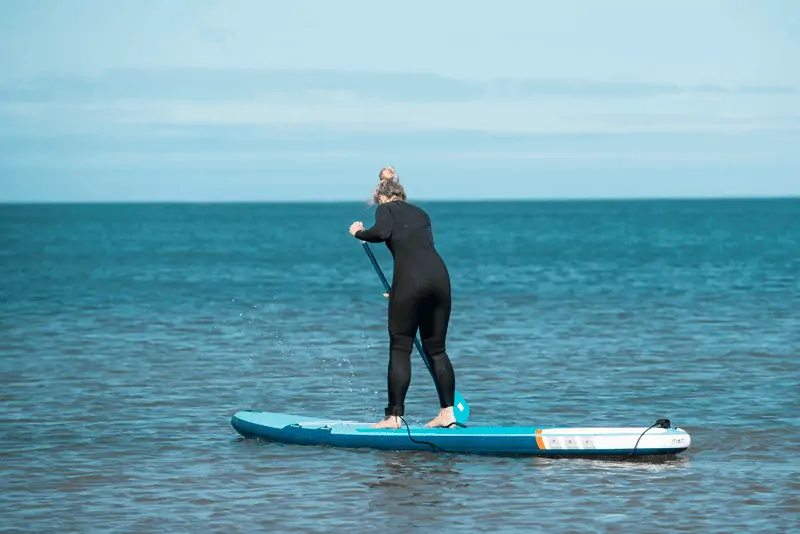I can’t tell you how many times I’ve fallen off my paddleboard, but it’s been enough to make me feel like I’m cursed on the water!
To be fair, most people fall off their board at one time or another- even those who have been paddling for years!
It’s just something that happens when you’re learning to balance on top of an unstable object while balancing yourself over waves and currents – there are so many things going against your natural sense of balance that it feels impossible to stay up!
But not to worry – if you’re a beginner, this is totally normal.
In fact – it’s expected.
[ez-toc]

Why do I keep falling off my paddleboard?
Here are some possible reasons why you might be falling off your paddleboard, and how to avoid it!
1) Your board is too big for you (or vice versa):
If your SUP is larger than 10′ long for a beginner, or if you’re under 5’4″ tall like me, there are going to be disadvantages to trying to stand on one of these boards.
That being said… if the board is too wide for your hips or too thick for your feet, this will result in tippiness- which means instability, wobbly hips, and falling over. Instead – find an inflatable SUP that fits.
2) You don’t know how to paddle for balance:
The most important skill in SUP is the ability to paddle. Rudding through waves and intersections is useful when riding a longboard, but won’t help you in flat water SUP.
The best way to avoid falling in your SUP is to be able to paddle for balance- at all times.
Learn more about this in my blog post here: The Two Most Important Paddling Skills for Stand Up Paddleboarding.
3) You get too far out of center:
Once you feel balanced on top of the board, it’s easy to start getting cocky about where you put your feet. can lead to taking your weight off the middle of the board.
The worst place to be is with your toes hanging over the front edge, and your heels hanging over the back edge- it’s called a “duck dive” and you’ll feel super wobbly and unstable if you’re there.
Don’t keep your knees locked: If you can’t bend at least a little bit, it’s going to be hard for you to maintain balance as you paddle around.
4) You don’t know which way is up:
If you’re face up to paddle, then you know which direction is up-and thus, the easiest way to stay balanced.
This isn’t just a handy acronym- it’s actually really easy to get turned around when you’re on top of your board and it only takes a few seconds.
I still remember finding myself face down in the water more than once when I started learning how to SUP!
5) You don’t know how to fall off gracefully:
This might be the most important tip on this list- if you know how to fall off, then you’ll never be afraid of falling off.
A lot of people (myself included) worry about falling off on purpose because they think it means they’re going to hit their head and drown or scrape up their knees and legs- but the truth is that if you know how to fall safely then these things don’t need to be a concern.
Learn more here: How To Fall Off Your Standup Paddleboard Safely .
6) You don’t have any SUP experience:
When you learn to snow ski, do you strap in before your first day of snowboarding class? Of course not!
You get plenty of practice on basic skills like walking and stopping so that by the time you try anything fancy it’s just habit.
The same goes for standup paddling!
If you’re not ready to catch waves, go into the flats, or try some SUP yoga poses then you should stick with easy stuff like practicing your balance on flat water first.
If you know how to paddle for balance and you know how to fall off gracefully, then it might be time to start trying something new but feel free to come back here if you need help feeling more confident about your skills before attempting anything too daring.
7) Practice at home with a balance board:
If you’re new to standup paddling and you don’t feel 100% confident about your balance on a paddleboard, try practicing at home first using a balance board for SUP training!
Here’s my favorite:
Revbalance 101 v2 – Balance Board Sports Trainer
This balance board is great for SUP training and learning balance.
It is a great way for SUP riders to learn about balancing skills and it can be used to help improve your SUP skills with different board sports too.
The Revbalance is a favourite in the SUP industry because of its versatility.
It’s available in three sizes, which are widely used in stand up paddle boarding for learning balance and stability skills.
The Revbalance is commonly used by SUP’ers as a way to help with their balance skills as w designedell as SUP fitn purposelyess training. which is
What is the Revbalance used for?
The Revbalance has been designed for all ages and abilities. Kids, adults, athletes or beginners can all use this board to learn about stability and balancing skills on water.
It’s a great tool for developing balance and core strength whilst exercising your legs muscles at the same time!
The best thing about this board is its endless possibilities! From using it with SUP’ing to skateboarding tricks it can be changed from one sport to another so simply.
How does it work?
The secret behind the Revbalance is its shape and size.
It has been designed to be the perfect height and width for your feet, while its length is short enough to make tricks achievable.
The roller at the front creates a strong grip on it while not limiting the balance development skills of the user.
It lets you lean forward which increases stability and reduces movement required by your body to stay balanced.
Is it normal to fall off paddleboard?
Yes its common to fall off a paddleboard…you may even find its expected!
With a little practice you’ll improve your balance and stability, but it will still be easy to fall off.
That’s because getting on and off of your paddleboard is an integral part of whitewater SUP.
Most beginner paddleboarders aren’t prepared for this…they expect the board to do all the work and stay upright no matter what they do.
Falling off can be frustrating at first, but you need to learn how to relax and take the inevitable spills with good humor.
If its any consolation, some advanced riders fall more than beginners too!
What else could cause me to fall off?
There are many reasons why you might fall off your paddleboard that have nothing to do with your paddling skills:
- The wind may blow you off course, or get underneath your paddleboard and tip you over.
- You may hit a wave at the wrong angle and fall over sideways.
- You could collide with another paddleboarder or kayaker in an accident, which knocks you off balance.
- It’s easy to slip of the back of your board when doing yoga poses, not paying attention…or just reaching for something that fell into the water.
- If your SUP is too big it will be harder to keep upright on choppy water – especially if paddling solo!
What are some tips for staying safe on my SUP?
Along with learning how to better balance on your paddleboard, safety depends largely on how well prepared you are for any adverse conditions you’re likely to encounter.
You should always wear a personal flotation device (PFD) when paddling on the open water, especially one designed for paddleboarding with extra padding where your board will hit your body if you fall overboard.
Many SUP paddlers also choose to wear helmets now too…especially flatwater paddlers who are at higher risk of colliding with wakes and waves from powerboats or cruise ships.
If you’ll be doing yoga poses on your paddleboard then choose a model that’s wider than most other boards which gives you more stability and makes it easier to hold poses without tipping over!
Finally, consider taking some lessons to learn how to properly balance on your new paddleboard.
How do you stay balanced on SUP?
Staying balanced on your paddleboard sounds straightforward, but many new SUP paddlers struggle to keep their board upright even in calm conditions.
Luckily it’s not that hard to learn how to properly distribute your weight while standing on the board.
The general rule is that your shoulders should be over the center of your paddleboard…not hanging off the side like you might see some tall guys doing!
Is it hard to balance on a SUP?
It’s not hard to balance on a paddleboard, but it is quite different from balancing on a bike or regular paddleboard.
You might need some time to learn how to properly distribute your weight and control your movements when standing up without falling off.
For example, most people struggle with the ‘T’ pose in yoga where you stand flat-footed with one foot in front of you and another behind you…but this is just fine for keeping yourself upright on the board!
When paddling you want both shoulders over the centerline of your SUP so that they can balance each other out if you sway too far to either side while paddling.
This will keep your board perfectly straight under you…not leaning towards
Final Thoughts
It is important to learn the proper balance on your board because it will keep you upright and prevent falls.
Learning how to distribute weight properly can be difficult, but once mastered this skill will help you stay balanced when standing up or paddling.
The key takeaway here is that falling off of a paddleboard isn’t always due to poor balancing skills; much like with any other sport, there are many reasons why someone could fall off their SUP!
